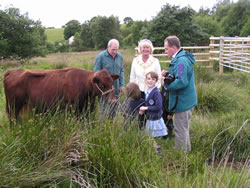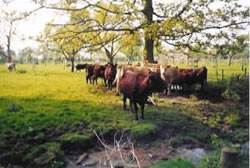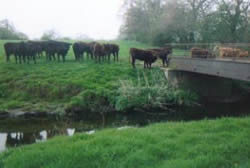Conservation Grazing and Organic Livestock Farming
Red Polls are a hardy breed of cattle, originating from an area with poor, light sandy soils and cold winds from the North Sea. They have a well developed rumen, able to convert low quality forage into high quality milk and beef. They are not picky grazers and will readily browse trees and shrubs. The Grazing Animals Project singles them out as "ideal for grazing public sites".
[four examples: a public body; a charitable conservation trust; a farmer under Higher Level Stewardship; an organic farmer]
For conservation grazing sites with public access, particularly where community involvement is important, cattle without horns and of medium size, like the Red Polls, seem less of a threat to people unfamiliar with livestock.
 The grazier, Terry Mancey, introduces the Red Poll cattle to the public at Barlaston Common |
With their glossy, conker red coats, Red Polls have good visual appeal, while their gentle temperament means the public will more readily form a bond with them. Barlaston Common in Staffordshire is designated a Grade 1 Site of Biological Interest and a Local Nature Reserve because of its mixture of heath, grassland and wooded habitat. Grazing is vital to protect the heath but also to improve the site's amenity value by maintaining the open habitat. Red Poll cattle have been selected to graze this site. The herd outwinters on the Staffordshire Moorland (LFA), with supplementary feeding of round bale silage, no concentrates. It includes regular winners in the showground at local, regional and national level, including Supreme Champion Red Poll at the Royal Show.
|
 Red Poll grazing on the Kemerton estate |
Kemerton Conservation Trust manages a range of different grassland habitats from flood meadows to traditional orchards with the aid of a suckler herd of Red Poll cattle. By varying the time and intensity of grazing, the trust are able to meet the grassland management objectives, agreed with Natural England under the Countryside Stewardship Scheme. The Red Poll beef cattle are produced in accordance with the Assured British Meat (ABM) Beef and Lamb Quality Assurance Scheme.
|
 Red Polls crossing the River Gowy |
Farmers with Higher Level Stewardship agreements can benefit from additional payments for keeping traditional breeds of cattle, such as the Red Poll. North West finalist for Natural England's Future of Farming Awards 2007, Huw Rowlands, grazes Red Poll cattle on his wetland areas at Grange Farm, Mickle Trafford to maintain a diverse sward structure which encourages lapwings, wading birds and inverterbrates. The wetland conditions do not pose a problem for the cattle with their dark, hard hooves. Their comparatively light weight prevents excessive damage to the sward. The beef is sold at the farm gate and at the local pub, which is also a noted Thai restaurant.
|
 Peter Melchett with his herd |
At Courtyard Farm, Norfolk, in their native East Anglia, Lord Peter Melchett, policy director of the Soil Association, keeps a herd of Red Polls on his organic farm. The aim of the farm is to combine profitable farming with high levels of biodiversity and public access. The cattle thrive on the species rich grassland near the farm and on the freshwater marshes which are part of the North Norfolk Coast RAMSAR site. Long lived and easy calving, Red Polls are not a high maintenance breed that requires regular, prophylactic vetinerary treatment. In particular, despite grazing marshes, liver fluke is not a problem in the herd. |
